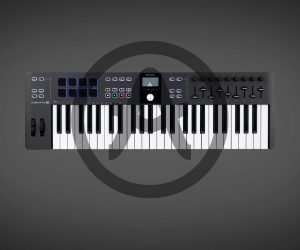
Arturia iProphet
Prophet wasn’t the saviour Sequential needed it to be, but now it’s been resurrected by Arturia you can touch it again.
I’ve only ever seen a Sequential Circuits Prophet VS once in my life, and it was a rack version. I spent an hour or so with it but was largely unimpressed; yet it wasn’t the sound that had me balking. Quite a contrast to the analogue-style synths I was using at the time, the sonics were stark, crystalline and glassy and the joystick thing allowed you to meander amongst four different oscillator waveforms. What turned me away from it was the rather cranky editing system. Any relevant information was relayed via a tiny dual-line LCD display, plus the whole machine felt like it could literally fall apart at any given moment. Still, that didn’t preclude the instrument becoming favoured with film and soundtrack composers. In a world of fuzzy analogue the Prophet VS was still a better proposition than attempting to edit a Yamaha DX7.
The Prophet VS used 12-bit samples and Curtis chips for the filters and envelopes. It was quite an amalgam. But what set it apart was the ‘vector’ synthesis. Movements recorded between the four oscillators were known as vectors — it was a revolutionary style of modulation. Add this to the traditional modulation possibilities of the Prophet VS and you’ve got one hell of an instrument. Shame Sequential was bought out by Yamaha.
Arturia, known for reincarnating vintage monoliths, has shoehorned the Prophet VS into iPad form. With the amenity of a touchscreen and more processing power than anyone could dream of in the 1980s, Arturia has released iProphet — a Prophet VS for everyone — for a mere 13 bucks.
iProphet is a staggering leap forward in terms of programmability compared with the original. With the app open in front of me it’s hard to understand why the original was such a wrestle in the first place. Editing amplitude and filter envelopes now has the advantage of a dedicated depiction across the entire iPad screen, as does the modulation matrix, with eight sources and 15 destinations. Unlike the original, Arturia has added delay, chorus, and distortion effects to the mix, along with a huge library of patches (650 or so). Plus, patches can be interchanged with Arturia’s desktop version of Prophet V. One feature slated for the original machine was oscillator sync. Sadly this never made the final production models. Arturia remedied this ommision and included the feature in iProphet. Being of the iPad persuasion, iProphet will lock in with Apple’s Inter-app audio for integration with GarageBand and similar applications. It offers Audiobus support, and unites with the latest answer to iOS integration, Tabletop — which works extremely well I can assure you.
Sonically, the iProphet will come in handy for anyone with their ear tuned to vintage electronica — think Vince Clarke, Japan, Jean Michel Jarre et al. It’s more than capable of emulating a Prophet 5, an Oberheim, a PPG, or indeed a Jupiter 8. If you really must, the iProphet can even do an impromptu stand-in for the Yamaha DX7.
While you’re considering the options, bear in mind the many other instruments Prophet VS gave rise to. When Yamaha swooped in to buy the ailing Sequential Circuits, the company was quick to jump onto the vector bandwagon with synths such as the SY-22 all the way through to the SY-77. Even the Korg Wavestation owes its genesis to the Prophet VS. If it’s dark and irksome, clear as crystal, or hard hitting punch-through-the-mix bass, the $13 iProphet will provide.
$12.99 on the App Store
www.arturia.com
















RESPONSES